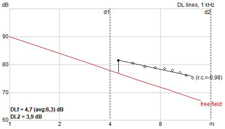The acoustics of work premises must be taken into account to limit the noise exposure of the workers: production halls, workshops, offices (a fortiori when it comes to open spaces) must present minimum characteristics to limit the reverberation of the noise on the partitions, which is otherwise often the cause of an increase in sound levels being too high and of a discomfort for the occupants (when they are not in a situation of auditory trauma).
 |
Predictive acoustics for work premises methods e.g. analytical or based on ray-tracing allow the evaluation of the performance of such spaces, particularly in relation to the absorption or in some cases: to diffraction of sound properties of different surfaces (including: floor, walls and partitions, ceiling and under-roof), and, in case of large volumes, considering the effect of atmospheric absorption.
Sometimes the reverberation time is a technical requirement (this is the case of an office or of associated spaces), but in most cases, the spatial decrease of the sound is a major criterion of quality of the sound environment.
Decrease of the sound level by doubling the distance to the source in a work space DL (as the case may be: empty of any machine or production facility or after installation of production machinery and equipment) is evaluated by considering more or less distant positions from a source of noise, as well as sound pressure level amplification DLf.
Often depending on the floor area of the premises, objective values must be taken into account - generally in France: to comply with the Decree of 30 August 1990 which is applicable to the construction or workspaces referred to in Article R. 235-11 of the Labor Code, where machines and apparatuses are able to expose workers to a daily noise exposure level exceeding 85 dB (A) or, otherwise, in the case of offices and associated areas for which the standard NF S 31080, which is envisaging several acoustic performance levels, is applicable -.
The walls of the work premises must often receive an acoustic correction, that is to say be lining with materials having sound absorption properties.
The specific acoustic properties of these materials, as well as the location and quantity that must be considered for each of them, then constitute output data of a predictive acoustics for work premises.
Predictive acoustics for work premises is an area of acoustic engineering for which ITS has reliable and accurate simulation tools.
Depending on the case, the reverberation time or the decrease of the sound level by doubling of distance to the source, also called spatial (sound) decay rate can, in case of a project entrusted to ITS, be the subject of a guarantee of result after works and verified on site according to measurement standards in force, using a noise generator and a sonometer.